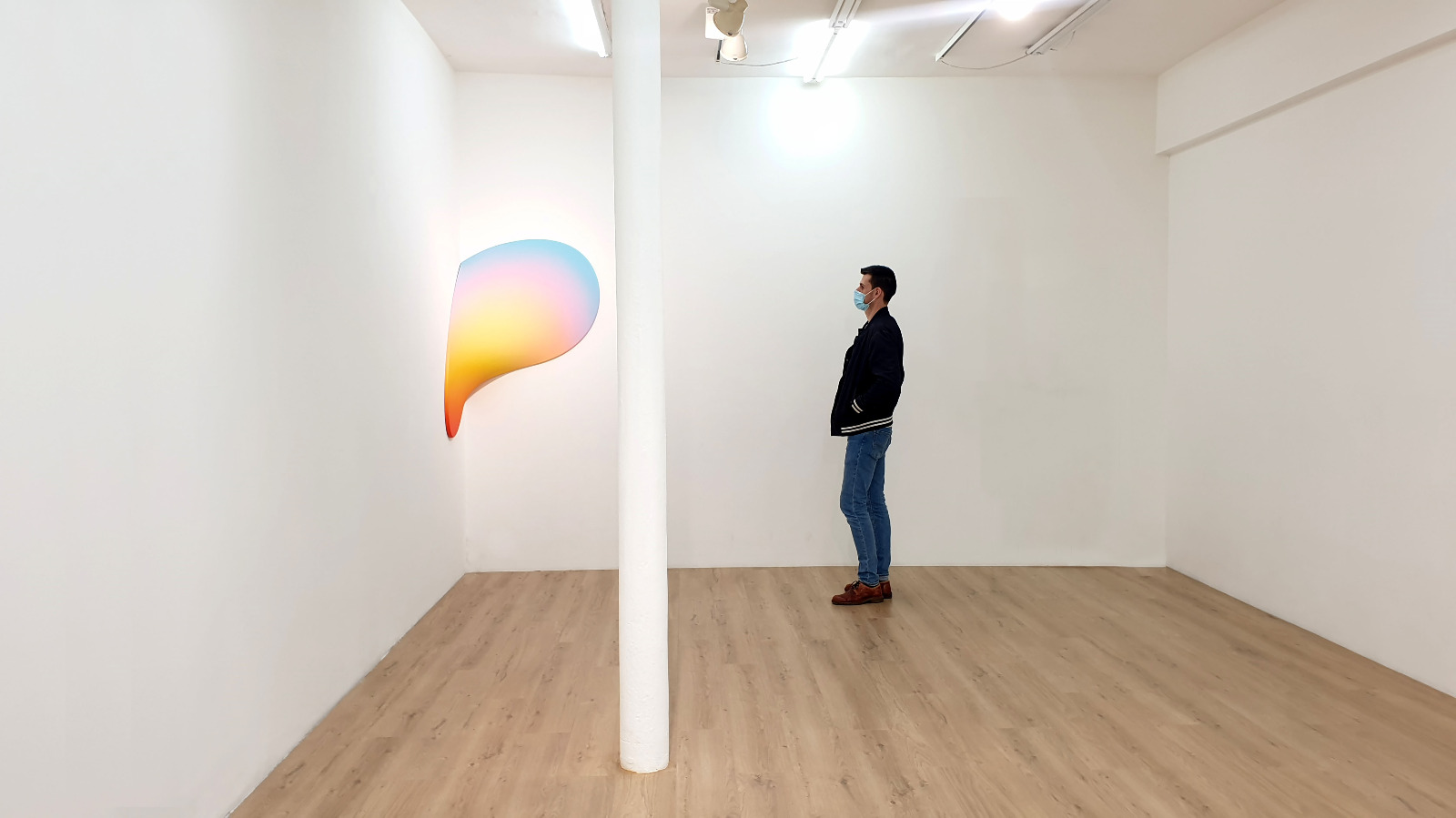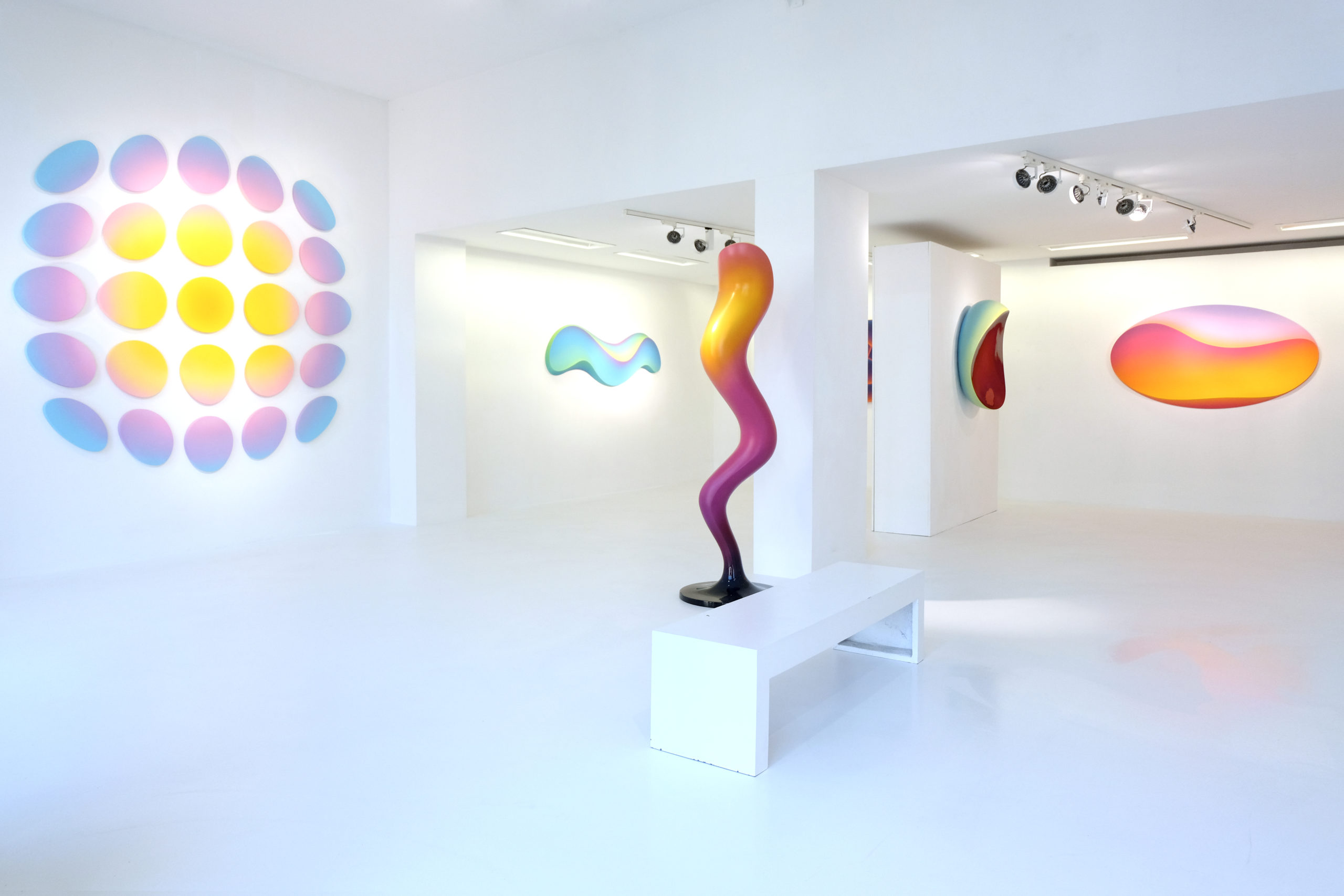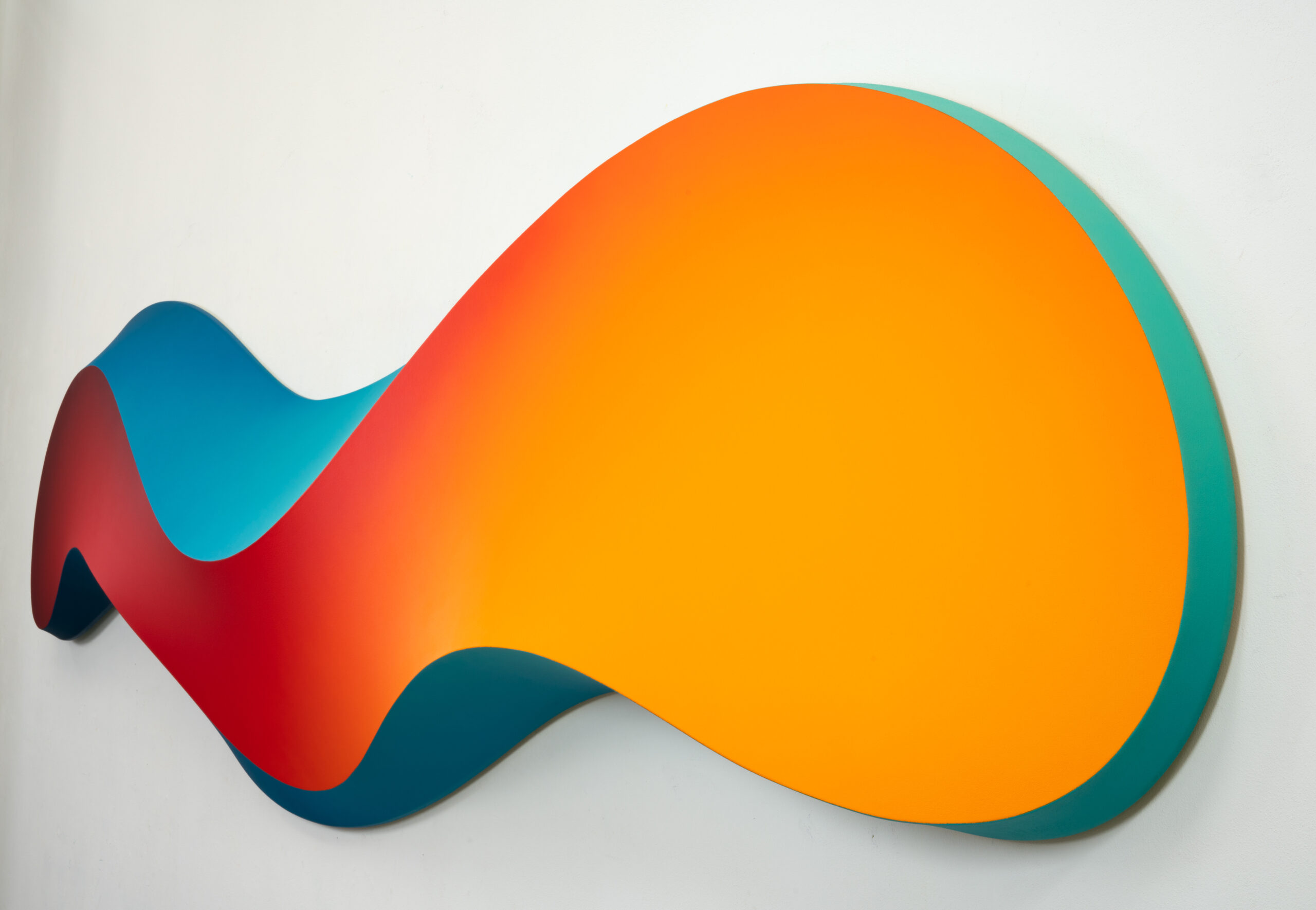From essay “Jan Kaláb's Portal to Euphoric Salvation”
As I view Jan Kaláb’s artwork, the light of the beauty he discovered in marine creature seems to penetrate me, and the warm, cozy light of my childhood that I had forgotten for a while gently surges within me. It is the light of the boundless wonder that used to be found in small joys, and the light of peaceful moments when worries and anxieties were nonexistent. As I gaze upon Jan Kaláb’s masterpieces, a wave of childhood memories come crashing over me, as though they had been waiting for this moment to resurface.
It is as if the artist’s oceanic dreamscape, where corals gather and blend, mirrors my own fragmented recollections of a time filled with beauty and wonder. Perhaps it is the sheer brilliance and vibrancy of his abstract forms that transport me back to a time when everything seemed possible, where every new discovery was like diving into a mesmerizing underwater world.
Suh Go-Eun, Seoul 2023
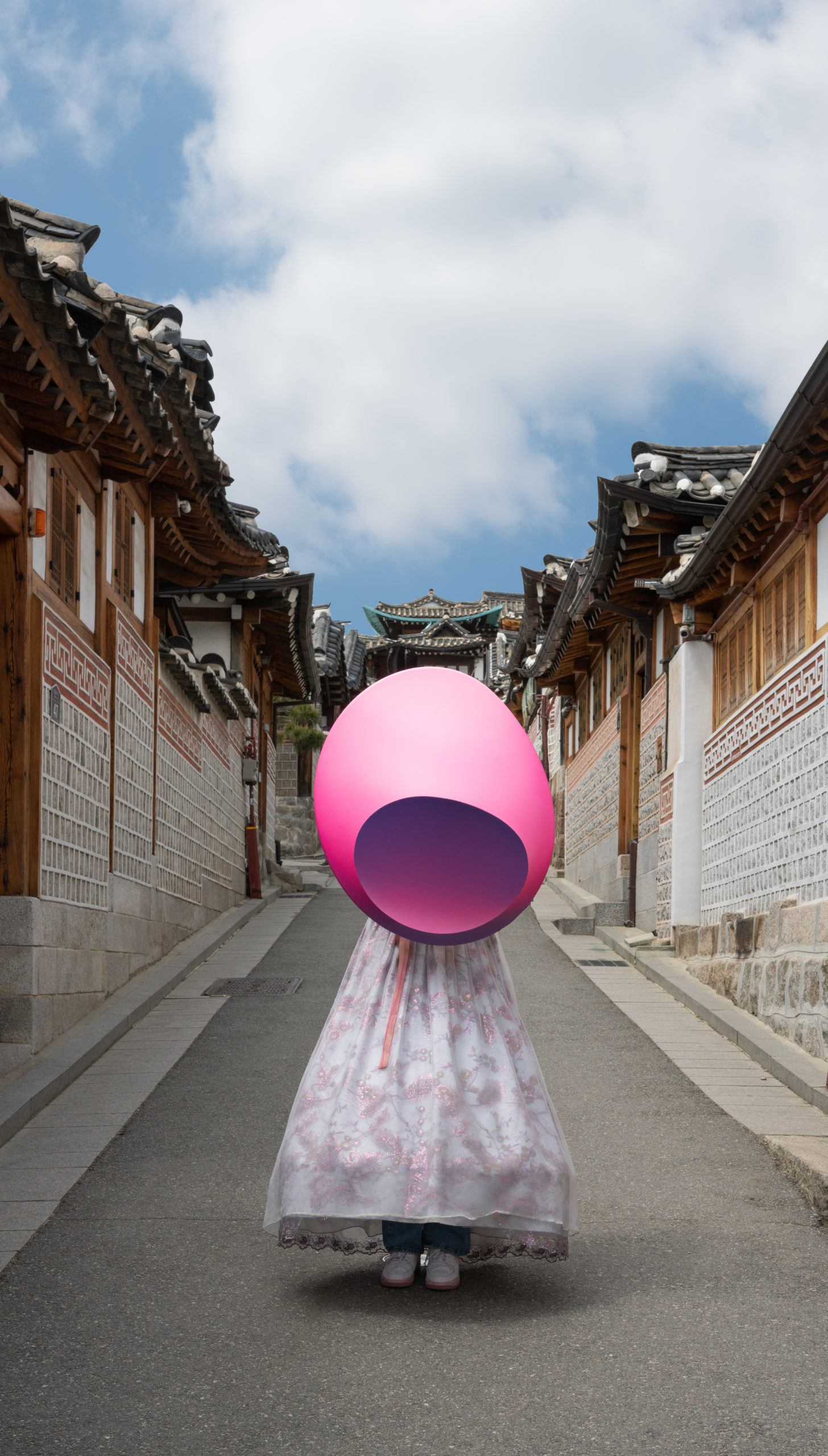
Roseate Jellyfish, 2023
80 x 70 x 20 cm, Acrylic on relief canvas
Bukchon Hanok Willage
From text “When the Shape Takes Over”
Kaláb experiments with the effects created by the juxtaposition of color and plays with the viewer’s position vis-à-vis the work. Yet one may wonder what such an artistic approach says about our world. Where does this research lead the artist? It is visual art research on the margins of sculpture, but one that says much about art’s need to overflow and to become embedded in unexpected spaces, such as the corner of a room or the corner of a ceiling.
The loss of spatial landmarks is at the center of Kaláb’s work, made in a technique resulting from a long transformation of his graffiti work. His art perfectly illustrates the salutary change in urban practice. Like our society with its “fluidities” (whether in the definition of human genders, the significance of social networks, the redefinition of personal and professional spheres, the search for impact, or even the accessibility of visual art to an increasingly large audience), the work of Jan Kaláb is a perfect, albeit abstract, illustration of a world in constant redefinition, an era defined by its elusive forms. Kaláb’s practice speaks of those forms that nature itself would hardly reveal.
The artist’s inspiration, the hand of man and his know-how, take us to another place. In his time, the surrealist artist Salvador Dalí sought to melt the landscapes of his imagination. Jan Kaláb plays with similar but much more abstract forms. It is also interesting to examine the importance of the point, often called the “dot,” among renowned artists such as Damien Hirst and Yayoi Kusama, both of whom have chosen to explore its possibilities in a chromatic proliferation approaching saturation. Kaláb offers a cocoon of serenity, giving us some peaceful rest thanks to his clever combination of colors. This organic artistic proposal is above all a conceptual stylistic research.
Magda Danysz (Danysz gallery), Paris 2021
Warped Sunset, 2021
installation view, Danysz gallery
120 x 82 x 59 cm, Acrylic on relief canvas
From “Jan's Pure Geometric Abstraction, a Welcoming Window to a New World”
Jan Kaláb’s refined and complex “Jan Kaláb Style Abstract” is based on the speed and scale of guerrilla graffiti that he practiced from a young age, as well as his exploration of new and experimental forms of graphic expression. His admiration for Kupka led him to develop his own formal language of “pure geometric painting,” which he completed while learning about Prague’s art, architecture, and design from Czech-born British architect Eva Jiřičná.
Jan’s pursuits of infinity, reinterpreted gravity, and constantly changing geometric experiments have become the driving force behind the universe he creates and establish new orders.
Kim Yoon-Sub Ph.D. in Art History (CEO of AIF Art Management), Seoul 2023
Solo show: Cosmic Spring
Installation view, Macadam Gallery, Brusells 2021
There is a light that never goes out
Organic forms were another defining feature of Atomic Age design. This style used nature-inspired forms to evoke living entities, from amoebas to planets to cells, microscopic and galactic visions, predominantly curvilinear shapes.
Another individual who dared to bet on form as a constitutive element of the artistic experience was the sculptor Constantin Brancusi – especially with his works entitled Fish (a small piece in bronze, from 1926, and another more massiv one, in marble, from 1930): “When you see a fish, you don’t think of its scales. You think of its speed, its floating, shimmering body seen through the water. I tried to express just that. If I made fins and eyes and scales, I would stop your movement and trap you by a pattern, by a form of reality. I just want the glimmer of your spirit”.
Probably affected by the images that prowl the pains of our time, marked by distance and tension between bodies, seeing some of the interactions between color and form in Kaláb they seem to resonate with both the largest nuclear explosions and microscopic, cellular-scale experimentation, like forms that happen in in vitro fertilization. Popularized by assisted reproduction techniques, In vitro is a Latin expression that designates all biological processes that take place outside living systems, in the controlled and closed environment of a laboratory. Art is certainly not this environment, it is strongly marked by social regimes – although the opacity of abstraction does not allow us to perceive this literally. To see such forms with free eyes for now is a task of the order of the impossible. There are those who prefer microscopes, there are those who choose brushes.
Ulisses Carrilho (Escola de Artes Visuais do Parque Lage), Rio De Janeiro 2022
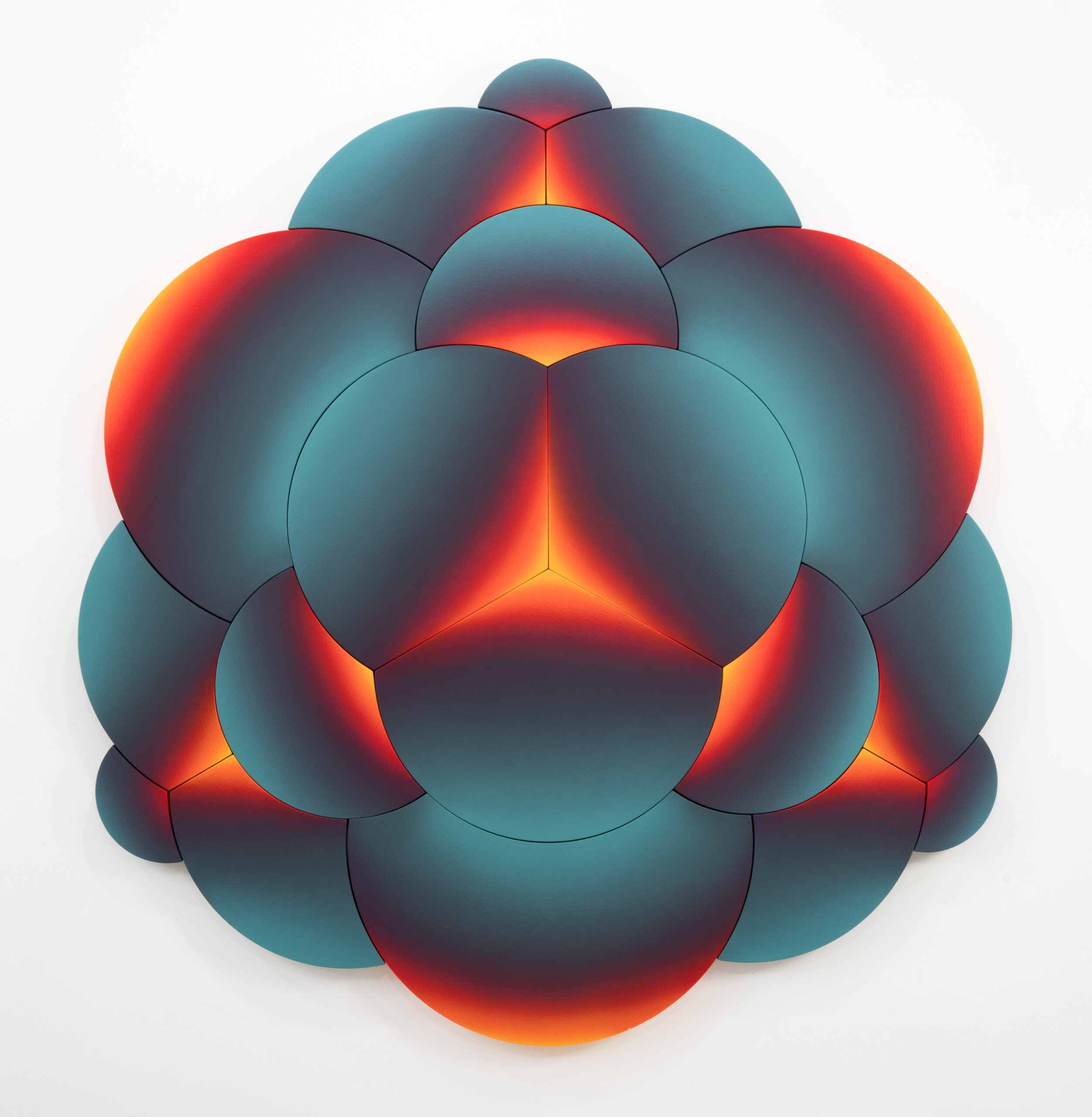
Symmetrical Explosion 522, 2022
159 x 151 cm, Acrylic on 18 canvases
From text “Force Diagram”
A little more than a century ago, the biologist and mathematician D’Arcy W. Thompson wrote that “the form of an object is a diagram of forces” (On Growth and Form, 1917), of internal and external forces that act on the object itself, shaping its form, the nucleus that allows the thing -the animal, Thompson said- to survive in the outside world, “for it is formed from without as well as from within”.
It seems to me that this is a good viewpoint to approach the paintings of the Czech artist Jan Kaláb (1978) and, especially, some of his most recent works that he is showing for the first time in València.
Ricardo Forriols (Polytechnic University of Valencia), Valencia 2019
Atomic Wave, 2021
100 x 330 x 20 cm, Acrylic on relief canvas
From text “From Piece to Paintings and Back Again”
The basis of his compositions are neither physical objects in terms of a depicted construction, nor captured states of objects as a reflection of momentary physical disposition, but a space that gradually and consciously opens up, in other words, a path which, through cyclical twists, leads towards a dark aperture in the distance. Even that, however, is not of a material nature. Its principal malleable substance is the depth, whilst the forming shape that provides contours is a circle. It is thus just an embodiment of another of the manifestations of infinity, which is actually Kalab’s central theme.
However, this is not all. From the formal point of view, his recent compositions have developed from crossing rectangular shapes to penetrating circles which are currently the principal organic element of his art works. The whole of Kalab’s spatial universe is composed and constructed with them, and every new circle, vanishing and simultaneously opening up somewhere else in the distance, is also their point. And this is exactly the moment in which Kalab’s bipolar nature of painter and writer quietly slips back in.
On the one hand,we are clearly experiencing another part of the series of his continuous artistic exploration of other possibilities within the geometry-inspired morphology, on the other hand, he comes full circle to the initial point of his name, except that what he would previously express in letters he has now encoded into his paintings through form, which, however, simultaneously defines the content. It is therefore more than symbolic that the vanishing point – that is to say the point in the distance, is actually an entrance into the next level of space. As before, his recent artworks also come in the form of 3D objects, and the fact that the “point” remains Point is demonstrated, as a sort of metaphorical link between these two poles.
Radek Wohlmuth, Praha 2013
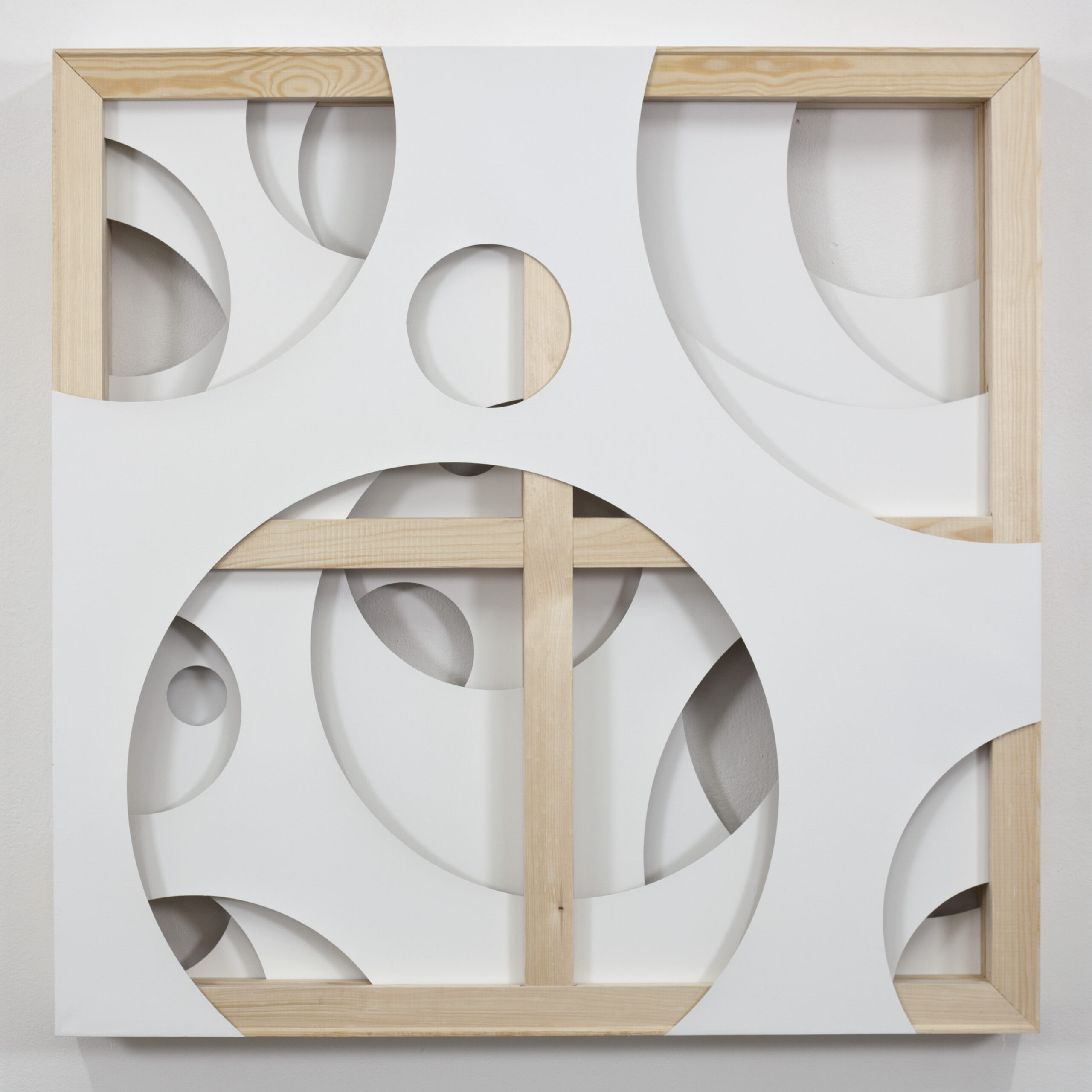
Alternate Planes 0415, 2025
100 x 100 x 8 cm, Acrylic on cut thu on 4 canvases
From text “Suspended Planes”
Kaláb’s latest works resonate with the approach of the pioneers of abstraction from the beginning of the last century who intro- duced both purely geometric space, made of austere, intersecting planes, and the cosmogonist space that exists outside the law of gravity and which they believe to open up interplanetary correlations. Kaláb handles both these elementary concepts, nowadays considered the inventions of modern painting, as constants which he adopted naturally, without studying the historical context: on the one hand he is attracted to axonometric projections, opening more and more, endless apertures whose end is nowhere in sight, on the other hand he contemplates bottomless depths, revealing the abyss filled with action the meaning of which transcends the painter’s consciousness.
On both those levels, symbolic forms, arising both from reassessment of the illusory perspective and psycho- logical structures that reflect the desire to transcend into the realm beyond sensory experience, are intertwined, each in harmony with the other. Kaláb thus draws upon the contrasting aspects of meaning that have been associated with art from the beginning of its existence, although, seen with the hindsight of many decades, they merely provide the margins for his decisions. He has arrived at them following a path of his own which arose in front of him naturally as a painter’s task, not by an intentional study of an already existing language that sees abstraction from a distance, as one of many possible painting styles.
PhDr. Karel Srp, Ph.D. (GHMP), Praha 2011

White Infinity 1220, 2020
90 x 60 cm, Acrylic on canvas
From text "POINT Show"
I was lucky to see him defend his diploma work in June 2006 in the Veletržní Palace. I was curious to know how he was going to fare. So far everything had gone well for him. After a short stay at the Academy of Arts, Architecture and Design in Prague (VŠUP) he attended the Acad- emy of Fine Arts (AVU). Here, at the most prestigious Czech art school, he continued to pursue that which he had been doing since the age of fifteen: graffiti and its variations. Kaláb managed to finish his studies at the Academy while fully concentrating on his favourite “street art disciplines” and not succumbing to the institutional pressures with which every student of AVU is confronted. He was the first graffiti artist to follow his own path through the Academy. He relentlessly modified a number of different letters (first Splesh, then Cakes and Point) to create an origi- nal visual language which harmoniously enriched the surroundings in which they appeared.
His professor, Jitka Svobodová, discovered his talent and let it grow; pro- fessors like her who do not impose their own ideas or turn students into their clones, are to be commended. In his diploma work entitled “Here is There” he summarized all his previous works, concentrating them – via the Internet – in one physical place, the Veletržní Palace. The commis- sion evaluating his work contained famous painters like Michael Rittstein and Jaroslav Róna. The latter admitted that Kaláb was the first graffiti artist he had met face to face; unbelievable in the 21st century…! I saw doubt in the eyes of the masters: the quality of the presented works was beyond question, but they were unable to understand that all of that stuff (classic graffiti murals, reliefs, little sculptures called “Pointies”, pavement art) was done in several weeks by one man.
He graduated with a straight A, unanimously, without any discussion. He left the Veletržní Palace, where the National Gallery stores its collection of modern art, as a Master of Arts.
Petr Volf (Faculty of Architecture at the Technical University in Liberec), Praha 2008
Point, Praha 2006
3 x 15 m, Wood, posters, acrylic paint

